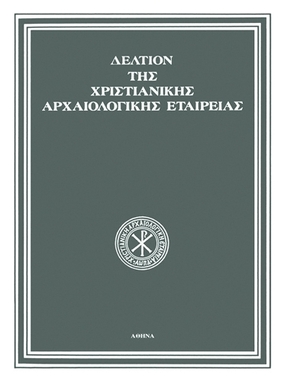Τα σύμβολα των ευαγγελιστών στη βυζαντινή μνημειακή τέχνη : Μορφή και περιεχόμενο
Part of : Δελτίον της Χριστιανικής Αρχαιολογικής Εταιρείας ; Vol.35, 1994, pages 79-86
Issue:
Pages:
79-86
Parallel Title:
Evangelist Symbols in Monumental Byzantine Art : Form and Content
Section Title:
Articles
Abstract:
The variety of forms in which the Evangelist symbolsappear, along with the Early Christian and Byzantinemonuments in which they are encountered led to therealisation of this study.The symbolism of the four Evangelists with their fourrevelationary beasts (angel-man, lion, bull and eagle)are quite old and spring on the one hand from the Bookof Revelations (4, 6-8) and on the other from the Visionof Ezekiel (1,4-10). The association of the four Evangelists with the four zodia was made on the basis of theabove texts by the Fathers of the Church (e.g. bishopIrenaeus of Lyon, Andrew of Caesaria, Anastasius ofSinai, St. Jerome, Epiphanius of Cyprus, St. Athanasiusand bishop Hippolytus of Rome) who, however, proposed various interpretations of these texts. Irenaeus ofLyon, for example, associated the angel-man with Matthew, the eagle with Mark, the bull with Luke and thelion with John, etc.In monumental art, the Evangelist symbols already appear in the Early Christian period and continue in various forms into the Byzantine era. For the Byzantineperiod in particular:1. The symbols of the Evangelists are projected behindthe mandorla of Christ, and with him constitute a Majestas Domini. One of the earliest examples of the Evangelist symbols in this form appears in the 5th-centurymosaic in the apse of the church of Hosios David (theLatomos monastery) in Thessaloniki.The Majestas Domini theme was popular in Byzantineart, particularly in monuments of the empire's Easternprovinces such as Egypt, Asia Minor, Ethiopia, Nubia,Georgia, Armenia but also in illuminated manuscriptsand, more rarely, on portable icons. The arrangement ofthe four beasts is always the same: above the angel-manwith the eagle and below the lion with the bull. InEgypt, however, the four zodia appear in most depictions in half section with six wings, and do not holdGospel books; thus they should not be associated withthe Evangelists since they appear in their capacity asrevelationary beasts. This detail aside, however, the Majestas Domini in apses of Coptic chapels is more generally associated with other elements that vary from monument to monument: wheels of fire, angels, personifications of the sun and the moon, visionary prophets, apostles etc. These poetical and fanciful depictions aim tounderscore Christ's divinity and His triumph throughthe Liturgy and especially the mystery of the DivineEucharist.2. At a later date, analogous depictions are encounteredin apses of Cappadocian churches, such as chapel 3 orthe church of the Three Crosses at Güllü Dere (first halfof the 10th century), at Tavsanh Kilise (ca 950-960), atKöy Ensesi Kilise in the village of Mamasum, at HaçliKilise (10th century), at Hagia Barbara at Soganh (1006or 1021) and at Hagios Theodoros at Sesum Bayn nearUrgiip (first half of the 11th century). In these monuments, Christ is seated on a throne from which protrudethe four Evangelist symbols in the arrangement mentioned in the previous example. A new element in a fewCappadocian churches is the appearance of the participles ΑΔΟΝΤΑ (singing), ΒΟΩΝΤΑ (shouting), KEKPAΓΟΤΑ (roaring) and ΛΕΓΟΝΤΑ (speaking), which accompany these symbols. These words refer to the liturgical text and more specifically to the introduction ofthe Epinikios Hymn: «Τον έπινίκιον υμνον φδοντα,βοώντα, κεκραγότα και λέγοντα».One of the oldest examples where the symbols wereidentified by inscriptions with the Evangelists is foundin the church of Hagios Merkourios on Corfou (1074-1075).Apart from the apses, the symbols of the Evangelistsappear in Byzantine domes (for example, in the churchof the Soter at Koropi in Attica, from about 1000) aswell as in dome pendentives, firstly in the West and laterin the Byzantine East: e.g. at Pelentri on Cyprus, andAteni in Armenia dating to the 14th century, etc.3. One final form in which the Evangelist symbolsappear is in the group of four-winged cherubim in thevision of Ezekiel, interpreted by the Fathers of theChurch as symbolising the unity of the four Gospels. Inthis manner, the four-winged cherubim are included indepictions of a liturgical character which appear inapses of churches in Egypt, Cappadocia and other Eastern regions from the 6th to the 13th century. At timesthe four-winged cherubim appear together with theEvangelist symbols surrounding Christ's mandorla orthrone. More rarely they can be found in pendentives ofdomed churches in Cappadocia and Cyprus, and oftenin the dome, where they are included in depictions of aliturgical character. Finally, in the church of HagiosPetros at Kalyvia Kouvara in Attica (1232), the fourwinged cherubim, identified by inscriptions with theEvangelists, is included in the Last Judgement in thenarthex.To conclude: the Evangelist symbols, which have a longhistory in Christian art, in various forms constitute anessential element in scenes of a liturgical or eschatological nature and are found mostly in monuments of theGreek world and the Eastern provinces of the Byzantineempire from the 5th to the 14th century.
Subject:
Subject (LC):




